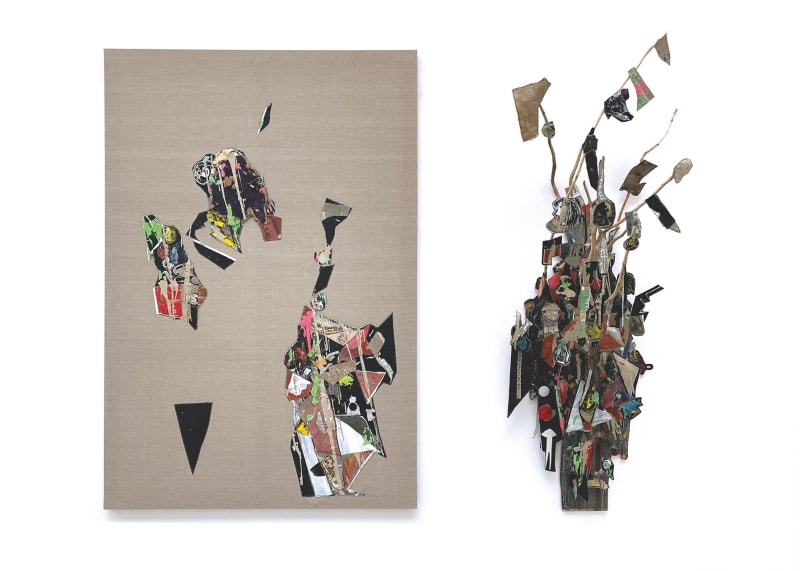Pierre Yves Bohm is a painter. His painting has the familiarity of art brut or DIY. It is a constant challenge to our certainties and knowledge. It does not correspond to any criteria of modernism and does everything, consciously or otherwise, to resist it. With its freedom of tone and temporal flexibility, it is an art that takes its time.
His painting invites the viewer to approach or distance themselves, and take the winding paths of this chaotic world through small pieces of hung canvas, strung together; to follow the little sewn, pierced stitches, to lose themselves in the details of objects clearly painted meticulously and seductively.
It can only resonate in each of us, in the meanders of consciousness and subconsciousness, an attitude towards the world, an introspection, symbols and energy, the essence of life. A mental and physical pathway, from one artwork to the next the exhibition is nothing but displacement, discrepancy, where everything is a dialogue and echo, inspired by his mother’s final voyage, in a profound ode to life.
In the beginning, there are Les déplacés (The Displaced). A large figure on a painted canvas, hung from bony branches, like a presence, a character in bas-relief, reigning supreme and solitary on the wall. But the gaze quickly turns to the left, to discover the emptiness of the canvas it has left: the displacement of this painted canvas panel, that Pierre Yves Bohm felt the need to banish from the canvas, after having violently installed it right in the middle. A desire to disrupt the tranquillity of interpretation, and disrupt the seductiveness of the super well painted, towards which we might content ourselves with calmly perusing all of the painted and sewn faces and elements. Interrupting the tranquillity of the gaze in this way has been achieved through the displacement of something that was foreign to begin with, and foreign, too, in its desire to construct. There has therefore been a displacement between elements that were not meant to meet and, for the viewer as well, something that has displaced their tranquillity. ‘I am obliged to perform radical acts to try to find fresh impetus. So, often, destruction is involved to recover this impetus.’
Initially, at heart, it represents the remains of the failure of a canvas that therefore ends up almost white. Above it, a suspended walking figure, Homme paysage Souno Chaïna. A large head, comprising a piece of tablecloth embroidered by his mother, re-embroidered onto the canvas by the son (le(s) fils : the son / the threads) – who is, undoubtedly, prodigal! A grotesque, moving head, with invisible eyes – ‘it is almost a Mexican “sugar skull”,’ Pierre Yves Bohm tells us. A kind of effigy of the painter, with a palette at the end of its arms, as though suspended. ‘These elements of embroidery or from my mother’s journal are captured: rather than preserving them, I have introduced them, displaced them, to bring them back to life.’
The prodigal son is a character created from patchwork, with embroidery fragments cut up and sewn from this journal. A kind of initiatory journey for the body, from childhood to adulthood, with all these maternal remnants. A kind of reliquary represented by the embroidery, the journals that were kept in boxes and that Pierre Yves Bohm has displaced, in some sense bringing them back to life.
Initially, the peinture verte — Sans titre [Green Paint – Untitled] or Linceul vert [Green Shroud] ‘was my reverse Pietà: I was the one holding my mother’. The image has completely disappeared, as though covered by a veil of green paint, a kind of shroud veiling the image of the mother, allowing only a few traces to appear from beneath an accumulation of amulets – ‘these are daubs of paint for me – fragments of painting, against a green monochrome – the kind of toxic green that you encounter on the walls of houses in Poland’. Displacement by disrupting the overpowering original image of a Pietà, towards this incredible, quasi-monochrome painting.
Chlakta-Vichta, with small demons borrowed from a former master of Siena, who have come to titillate this sleeping figure, hanging, with its fat head, like nightmares deriving from the noisy clutter of the world — The Sleep of Reason Produces Monsters . . . Goya dreamed. It is possible to sketch out his body, nevertheless soothed, constructed from a grid of pierced lines, small dots of white paint, that we can follow like an invitation to accompany him . . . into his nightmares.
Pierre Yves Bohm stops painting when he attains grace — the primary gesture, as Eugène Leroy would have said, with whom the artist maintains a long conversation. Between pleasure and impulse, seduction and destruction, attraction and repulsion, the painting of Pierre Yves Bohm, of an Unsettling Strangeness (Inquiétante Etrangeté*), disturbs, disconcerts, overwhelms, and enchants us.
Evelyne-Dorothée Allemand
August 2021
* L’Inquiétante Etrangeté, Pierre Yves Bohm, Max Neumann, Daniel Pommereulle, Antoni Ros Blasco, Royan, Centre d’Arts Plastiques, 3 July–19 September 2021

